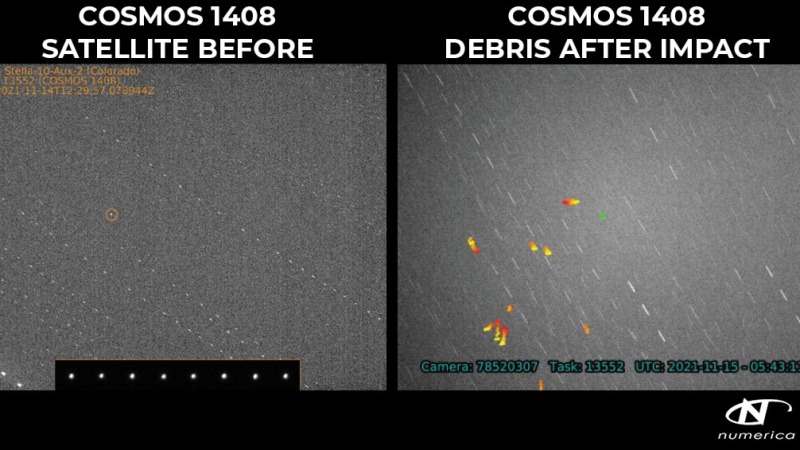Space debris from Russian anti-satellite missile test spotted in telescope images and video
You can see the doomed satellite before and after impact.
Pieces of a shattered Soviet-era satellite are visible in new telescope images after its destruction by a Russian anti-satellite weapons test on Monday (Nov. 15).
The images were captured by Numerica Corp., a Colorado-based company that provides tracking of space debris objects, and shared by the company's partner Slingshot Aerospace on Twitter. They show images and video of the debris in the wake of a direct-ascent anti-satellite test by Russia Monday that sent a missile from the ground to destroy a defunct satellite called Cosmos 1408.
The telescopic footage shows just some of the more than 1,500 trackable pieces of debris from Cosmos 1408 after its destruction by Russia. The U.S. Space Department, U.S. military officials and NASA administrator Bill Nelson are among the authorities condemning Russia for the act, which they said put the International Space Station at risk from the debris.
Related: The worst space debris events of all time
In a description with the images, Slingshot said Numerica "imaged the debris field created by the Russian anti-satellite test against #Cosmos1408." Numerica has a global telescope network and tracking software to assist in space domain awareness, according to its website.
Our #SlingshotBeacon partner, @Numerica_Corp, leveraging their global telescope network, imaged the debris field created by the Russian anti-satellite test against #Cosmos1408 in #LEO causing alarm to the #ISS crew, satellite operators, and spacefaring nations. pic.twitter.com/uK2NOmVHnrNovember 15, 2021
While Slingshot said Numerica is wholly responsible for the images, Slingshot told Space.com that it also has a product called Slingshot Beacon that uses data feeds from several sources for space debris tracking.
"We will analyze data feeds and Conjunction Data Messages (CDMs) from the U.S. government and other sources to present to space operators," marketing manager Madeline Reto said in an e-mail Tuesday (Nov. 16). "We determine which of their assets are at high risk of conjunctions. In situations like this, operators can get thousands of government CDMs so [that] Slingshot ensures customers only have to track the high risk ones."
Breaking space news, the latest updates on rocket launches, skywatching events and more!
In addition to these images, Slingshot Aerospace’s partner @numerica_corp has also provided a video from shortly after impact. The circled areas show the newly created debris in LEO from the Russian anti-satellite test (#ASAT) against #Cosmos1408. pic.twitter.com/E1FZbjVZEyNovember 15, 2021
Already the event has had ripple effects on international space operations. The seven-person Expedition 66 crew, which includes two Russian cosmonauts and three American astronauts, took temporary shelter in their return ships Monday as the orbiting complex passed by the debris cloud.
The space station is said to be moving through the debris field every 90 minutes; it orbits at roughly 250 miles (400 km) above Earth. Space debris tracker LeoLabs suggests the cloud of satellite pieces ranges in altitude between 273 miles and 323 miles (440 to 520 km) above Earth.
China also has a low-Earth orbit Tiangong space station module, Tianhe, that currently has three astronauts on board. It is unclear if the crew is taking any special measures as a result of the incident. Tianhe's average altitude is roughly 229 miles (368 km).
Russia and the United States are the major partners of the ISS, and their collaboration on the project dates to the early 1990s amid occasional spats between the countries, including reported threats by Russia to leave the ISS program in June.
In August, NASA and Roscosmos said their collaboration is still strong despite a July incident that saw the newly arrived Russian Nauka module accidentally tilt the space station by 540 degrees, causing a temporary spacecraft emergency. The astronauts were in no danger, NASA said at the time. Thruster misfirings on a Russian Soyuz MS-18 spacecraft altered the ISS orientation again in October for about 30 minutes.
A NASA statement about the new debris incident Monday noted the hatches between the U.S. and Russian side of the space station segments remain open.
Follow Elizabeth Howell on Twitter @howellspace. Follow us on Twitter @Spacedotcom and on Facebook.

Elizabeth Howell (she/her), Ph.D., was a staff writer in the spaceflight channel between 2022 and 2024 specializing in Canadian space news. She was contributing writer for Space.com for 10 years from 2012 to 2024. Elizabeth's reporting includes multiple exclusives with the White House, leading world coverage about a lost-and-found space tomato on the International Space Station, witnessing five human spaceflight launches on two continents, flying parabolic, working inside a spacesuit, and participating in a simulated Mars mission. Her latest book, "Why Am I Taller?" (ECW Press, 2022) is co-written with astronaut Dave Williams.

